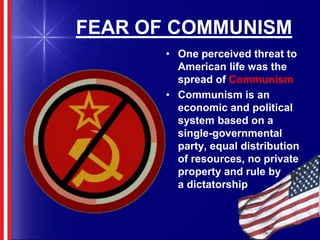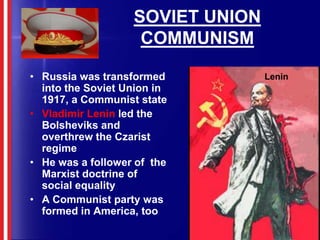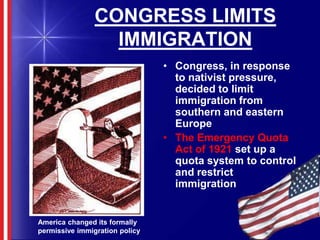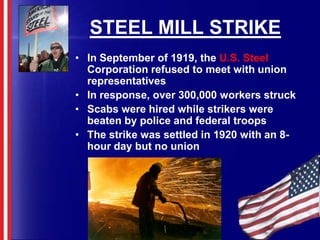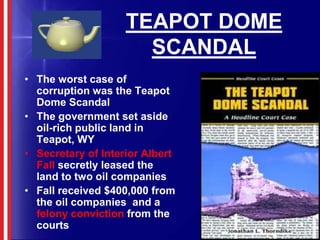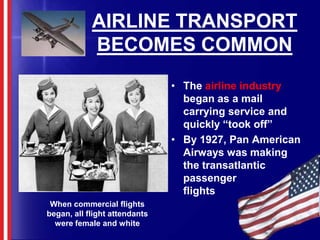Politics Of The 1920s
- 1. POLITICS OF THE ROARING 20’S
- 2. SECTION 1: AMERICAN POSTWAR ISSUESThe American public was exhausted from World War IPublic debate over the League of Nations had divided AmericaAn economic downturn meant many faced unemploymentA wave of nativism swept the nation
- 3. ISOLATIONISMMany Americans adopted a belief in isolationismIsolationism meant pulling away from involvement in world affairs
- 4. FEAR OF COMMUNISMOne perceived threat to American life was the spread of CommunismCommunism is an economic and political system based on a single-governmental party, equal distribution of resources, no private property and rule by a dictatorship
- 5. SOVIET UNION COMMUNISMRussia was transformed into the Soviet Union in 1917, a Communist stateVladimir Lenin led the Bolsheviks and overthrew the Czarist regimeHe was a follower of the Marxist doctrine of social equalityA Communist party was formed in America, tooLenin
- 6. SACCO & VANZETTIThe Red Scare fed nativism in AmericaItalian anarchists Sacco & Vanzetti were a shoemaker and a fish peddlerConvicted of robbery and murder despite flimsy evidence, their execution was symbolic of discrimination against radical beliefs during the Red Scare
- 7. THE KLAN RISES AGAINAs the Red Scare and anti-immigrant attitudes reached a peak, the KKK was more popular than everBy 1924, the Klan had 4.5 million members
- 8. CONGRESS LIMITS IMMIGRATIONCongress, in response to nativist pressure, decided to limit immigration from southern and eastern EuropeThe Emergency Quota Act of 1921 set up a quota system to control and restrict immigrationAmerica changed its formally permissive immigration policy
- 9. A TIME OF LABOR UNRESTStrikes were outlawed during WWI, however in 1919 there were more than 3,000 strikes involving 4 million workers
- 10. BOSTON POLICE STRIKEBoston police had not received a raise in years and were denied the right to unionizeThe National Guard was calledNew cops were hired
- 11. STEEL MILL STRIKEIn September of 1919, the U.S. Steel Corporation refused to meet with union representativesIn response, over 300,000 workers struckScabs were hired while strikers were beaten by police and federal troopsThe strike was settled in 1920 with an 8-hour day but no union
- 12. COAL MINERS’ STRIKELewisIn 1919, United Mine Workers led by John L. Lewis called a Strike on November 1Lewis met with an arbitrator appointed by President WilsonLewis won a 27% pay raise and was hailed a hero
- 13. 1920s: TOUGH TIMES FOR UNIONSThe 1920s hurt the labor movement Union membership dropped from 5 million to 3.5 millionWhy? African Americans were excluded from membership and immigrants were willing to work in poor conditionsFord Foundry workers in 1926; only 1% of black workers were in Unions at the time
- 14. SECTION 2: THE HARDING PRESIDENCYWarren G. Harding’s modest successes include the Kellogg-Briand Pact which renounced war as a means of national policy (signed by 15 nations, but difficult to enforce), and the Dawes Plan which solved the problem of post-war debt by providing loans to Germany to pay France/Britain who then paid the U.S.Harding 1920-1924
- 16. SCANDAL HITS HARDING The president’s main problem was that he didn’t understand many of the issues
- 17. Several of Harding’s appointee’s were caught illegally selling government supplies to private companiesTEAPOT DOME SCANDALThe worst case of corruption was the Teapot Dome ScandalThe government set aside oil-rich public land in Teapot, WYSecretary of Interior Albert Fall secretly leased the land to two oil companiesFall received $400,000 from the oil companies and a felony conviction from the courts
- 18. SECTION 3: THE BUSINESS OF AMERICAThe new president, Calvin Coolidge, fit the pro-business spirit of the 1920s very wellHis famous quote: “The chief business of the American people is business . . .the man who builds a factory builds a temple – the man who works there worships there”President Calvin Coolidge 1924-1928
- 19. AMERICAN BUSINESS FLOURISHESBoth Coolidge and his Republican successor Herbert Hoover, favored governmental policies that kept taxes down and business profits upTariffs were high which helped American manufacturersGovernment interference in business was minimalWages were increasing
- 20. THE IMPACT OF THE AUTOThe auto was the backbone of the American economy from 1920 through the 1970sIt also profoundly altered the American landscape and societyThe Ford Model T was the first car in America. It came only in black and sold for $290. Over 15 million were sold by 1927.
- 21. IMPACT OF THE AUTOAmong the many changes were:Paved roads, traffic lightsMotels, billboardsHome designGas stations, repair shopsShopping centers Freedom for rural familiesIndependence for women and young peopleCities like Detroit, Flint, Akron grew By 1920 80% of world’s vehicles in U.S.
- 22. AIRLINE TRANSPORT BECOMES COMMONThe airline industry began as a mail carrying service and quickly “took off”By 1927, Pan American Airways was making the transatlantic passenger flightsWhen commercial flights began, all flight attendants were female and white
- 23. AMERICAN STANDARD OF LIVING SOARSThe years 1920-1929 were prosperous ones for the U.S.Americans owned 40% of the world’s wealthThe average annual income rose 35% during the 1920s ($522 to $705)Discretionary income increased
- 24. ELECTRICAL CONVENIENCESWhile gasoline powered much of the economic boom of the 1920s, the use of electricity also transformed the nationElectric refrigerators, stoves, irons, toasters, vacuums, washing machines and sewing machines were all new
- 25. MODERN ADVERTISING EMERGESAd agencies no longer sought to merely “inform” the public about their products They hired psychologists to study how best to appeal to Americans’ desire for youthfulness, beauty, health and wealth“Say it with Flowers” slogan actually doubled sales between 1912-1924
- 26. A SUPERFICIAL PROSPERITYMany during the 1920s believed the prosperity would go on foreverWages, production, GNP, and the stock market all rose significantlyBut. . . .
- 27. PROBLEMS ON THE HORIZON?Businesses expanded recklesslyIron & railroad industries fadedFarms nationwide suffered losses due to overproductionToo much was bought on credit (installment plans) including stocks



